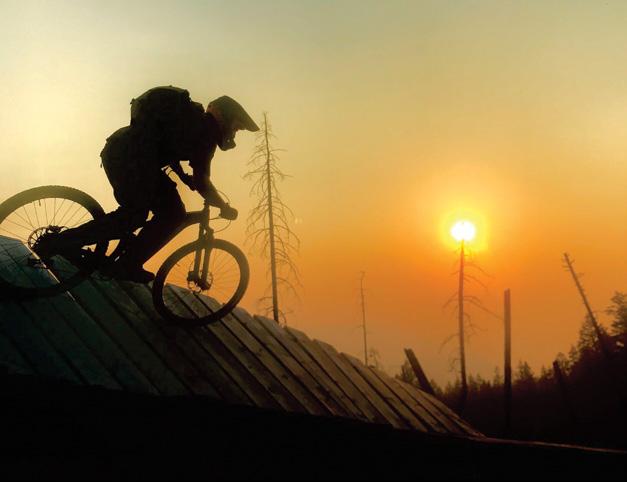
29 minute read
Book Review: Changing Tides – An Ecologist's Journey to Make Peace with the Anthropocene
Changing Tides An Ecologist’s Journey to Make Peace with the Anthropocene
By Alejandro Frid New Society Publishing
Advertisement
Book Review by Sage Birchwater
The latest book by Bowen Island marine ecologist Alejandro Frid carries a message of hope in a world fraught with worrying environmental uncertainty. Five years ago, Frid published his first book on a similar theme, A World For My Daughter: An Ecologist’s Search for Optimism (Caitlin Press 2015). There, the author’s brilliant analysis of the ecological stress facing the planet, measured from the relatively pristine environment of the Central Coast of British Columbia, suggested a dire future.
His latest work, Changing Tides, offers more hope.
Frid says he made a conscious shift to find optimism. “Like many of my scientific colleagues, I am often overwhelmed,” he says. “Climate change, ocean acidification, species extinctions: we contemplate these difficult issues constantly. I know well what it is like to just want to give up.”
For the past three decades Frid has worked as an ecologist on marine conservation with modern Indigenous peoples of the Nuxalk, Heiltsuk, Kitasoo/Xai’xais, and Wuikinuxv nations. He is seeking to merge science and Indigenous knowledge to steer us toward a more benign Anthropocene. Anthro-what, you say? Anthropocene is an environmental buzzword coined by Nobel laureate atmospheric chemist Paul Crutzen back in 2000. It refers to our current geological age where human activity has become the most dominant influence on the planet, including the climate and the environment.
Frid finds his optimism by fusing Western science with the intrinsic knowledge and practices of Indigenous cultures. He says aboriginal societies all over the world developed intentional and socially complex practices for sustainable resource management over thousands of years. The book details his research with Indigenous managers on the Central Coast in co-operation with Department of Fisheries officials to improve understanding of depleted marine habitats and species. It’s a process that requires understanding and respect. A learning curve for everyone involved. In the last decade Frid expanded his ecological footprint to the Chilcotin Plateau where the headwaters of the Chilcotin River are a vital spawning and rearing habitat for salmon that infuse the marine environment he knows so well.
Several years ago, Alejandro and his daughter, Twyla Bella, then about 10, spent the night at our place in Williams Lake, along with two other dads and their daughters from Bowen Island. They were on their way to Nemiah Valley to attend the XeniGwet’in Culture Week at Naghtaneqed School. There they learned firsthand the importance of Pacific salmon to the Tsilhqot’in people and the austere measures they have taken to preserve the fishery.
They learned about the stand taken by the Tsilhqot’in to prevent a copper and gold mine at Teztan Biny (Fish Lake) that would endanger salmon survival in the whole Chilcotin River system. They came away refreshed and invigorated by the cultural sharing, inspired by the stewardship role of the XeniGwet’in in their caretaker area.
As an ecologist Frid sees the vital connection between healthy salmon stocks in the marine environment and the integrity of spawning grounds in the headwaters of streams feeding the Pacific.
The cover of Changing Tides pictures a man drumming, standing on the shore of Teztan Biny. Above the drummer is a swirling circle of fish. The author explains the significance.
Alejandro says his dad, Samuel Frid, acquired the drum from Kwakwaka’wakw artist Eugene Hunt in the 1980s, then passed it on to him in the 1990s. In September of 2018 Alejandro gifted the drum to Cecil Grinder and Doreen William as a wedding present. Cecil is an inspirational cultural leader who has led the charge identifying the spiritual significance of Teztan Biny. Doreen’s father, the late Joseph William, grew up there.
Frid says the web of social, geographic, and cultural relationships depicted on the cover of the book reflects the trade economy, crosspollination, and adaptability that are integral to First Nations. “These are all major themes in the book,” he says. Changing Tides is an attempt to chart a course through the world as it is today toward a positive future.
“Catastrophe can be our teacher,” he concludes. “But it need not be the only one... We are on a knife’s edge, and this is the time to act.”
He says his daughter gives him a reason to keep writing. “It’s my hope that this book will do its small part in inspiring her, and the rest of us, to do all we can to rebuild a world where people from different cultures relate to each other and to our non-human kin, with respect, reciprocity, and love,” Frid says. Copies of Changing Tides are available at the Open Book in Williams Lake or wherever great books are sold. It’s an important narrative worth checking out. -GG
Sage is a freelance writer and lives in Williams Lake with his partner, Caterina. He has been enjoying the rich cultural life of the CaribooChilcotin Coast since 1973.
Choosing Store Bought Fruit and Veggies Dirty Dozen or Clean 15?
Article by Jessica Kirby
Since 2004, the Environmental Working Group (EWG) has released an annual list of the Dirty Dozen and Clean 15—produce items that contain the highest and lowest concentrations of pesticides. The purpose is to promote the value of shopping organically with a specific focus on balance.
“The Dirty Dozen is a list of products we recommend buying organically,” EWG says. “We believe the Clean 15 are the safest foods to buy conventionally. EWG recommends buying organic whenever possible—reducing your exposure to pesticides is a smart move and buying organic sends a message that you support environmentally friendly farming practices that minimize soil erosion, safeguard workers, and protect water quality and wildlife.
“However, we know that organics are not accessible or affordable for everyone, so we created EWG’s Shopper’s Guide to Pesticides in Produce to help consumers make the healthiest choices given their circumstances.” The lists are assembled based on data from tests conducted by the United States Department of Agriculture (USDA) and the USDA's Pesticide Testing Program and the Food and Drug Administration. Researchers collect data by washing and / or peeling the produce to replicate the process a consumer would use when preparing the food to eat.
Organic food shoppers generally list avoiding consuming pesticides as their main motivation for doing so. According to a 2013 study published by the National Center for Biotechnology Information, evidence on the relationship between chronic illness and exposure to pesticides is overwhelming.
“There is a huge body of evidence linking exposure to pesticides with elevated rate of chronic diseases such as different types of cancers, diabetes, neurodegenerative disorders like Parkinson, Alzheimer, and amyotrophic lateral sclerosis (ALS), birth defects, and reproductive disorders,” the study says.
A development that turned the Dirty Dozen / Clean 15 phenomenon on its head last year was kale’s appearance in the Dirty Dozen. Coming in third, right after strawberries and spinach, which retained their spots from previous years, kale tested positively for pesticide called Dacthal, aka DCPA, on 60 percent of the samples and 92 percent carried at least two different pesticide residues. Dacthal has been listed by the Environmental Protection Agency (EPA) as a potential human carcinogen for more than 20 years, and its use has been illegal in Europe for a decade.
“We were surprised kale had so many pesticides on it, but the test results were unequivocal,” said EWG Toxicologist Alexis Temkin, Ph.D, in a press release from EWG. “Fruits and vegetables are an important part of everyone’s diet, and when it comes to some conventionally grown produce items, such as kale, choosing organic may be a better option.”
However, the EWG quotes nutritionist Jaclyn London in her article for Good Housekeeping: “There is evidence suggesting that eating kale can reduce one's risk of chronic disease, lower blood pressure, and improve bone health—so it’s up to you to decide if the benefits outweigh the risks.”
Overall, nearly 70 percent of the conventionally grown produce sold in the United States comes with pesticide residues, according to EWG’s analysis, reported in a press release from the organization.
“The main route of pesticide exposure for most Americans who do not live or work on or near farms is through their diet,” said EWG Research Analyst Carla Burns. “Studies have shown that eating fruits and vegetables free of pesticides benefits health, and this is especially important for pregnant women and children.”
The American Academy of Pediatricians Council on Environmental Health emphasizes that children’s exposure to pesticides should be as limited as possible. Pesticide exposure during pregnancy and early childhood increases the risk of brain tumors, leukemia, neurodevelopmental defects, and other adverse birth outcomes.
EWG recommends consumers purchase organic versions of produce on the Dirty Dozen list. When organic versions are unavailable or not affordable, EWG advises consumers to continue eating fresh produce, even if conventionally grown.
“The health benefits of a diet rich in fruits and vegetables outweigh the risks of pesticide exposure,” Burns said.
In Canada, pesticide use is regulated by Health Canada, and the Canadian Food Inspection Agency monitors residue limits in both domestic and imported food.
The best choice is to support local food initiatives and to buy directly from a local farmer or shop at a Farmers’ Market, there
• More than 90 percent of samples of strawberries, apples, cherries, spinach, nectarines, and kale tested positive for residues of two or more pesticides.
• Avocados and sweet corn were the cleanest. Less than 1 percent of samples showed any detectable pesticides.
• More than 70 percent of fruit and vegetable samples on the Clean Fifteen list had no pesticide residues. Only 6 percent of Clean Fifteen fruit and vegetable samples had two or more pesticides.
Visit www.ewg.org for more information.
EWG's 2019 Dirty Dozen
EWG's 2019 clean 15
1. Strawberries 2. Spinach 3. Kale 4. Nectarines 5. Apples 6. Grapes 7. Peaches 8. Cherries 9. Pears 10.Tomatoes 11.Celery 12. Potatoes
1. Avocados 2. Sweet corn 3. Pineapples 4. Frozen sweet peas 5. Onions 6. Papayas 7. Eggplants 8. Asparagus 9. Kiwis 10.Cabbages 11.Cauliflower 12. Cantaloupes 13. Broccoli 14.Mushrooms 15. Honeydew melons
you can meet the hardworking people who grow your food and find out about their growing methods. Another great option is to experience the satisfaction and health benefits of growing your own produce from natural, organic, or heirloom seeds every season. -GG
Jessica Kirby is a freelance editor and writer covering the environment, lifestyles, and the built environment for publications across Canada and the United States. She can usually be found among piles of paper in her home office or in the Vancouver Island wilderness enjoying nature's incredible bounty.



New Toxic Ten Guide Top Chemicals for Canadians to Avoid in Skincare Products
Environmental Defence has launched its new Toxic Ten Skincare Guide to help Canadians make safer and more informed choices when shopping for cosmetics and personal care products.
“Canadians are increasingly concerned about the impacts of toxic chemicals in their bodies and the environment,” says Muhannad Malas, toxics program manager at Environmental Defence. “Our new guide lists 10 harmful chemicals, or groups of chemicals such as phthalates and Teflon-like chemicals known as PFAS, that consumers should avoid to better protect their health and the environment.” “It is critically important that consumers make smart decisions to avoid products containing known and potentially toxic and persistent compounds,” says Dr. Miriam Diamond, professor in the Department of Earth Sciences at the University of Toronto. “But making smart decisions isn’t always possible without labelling. When in doubt, remember to reduce use first, which can protect not only yourself, but also workers who make the products and the environment that receives the product when you wash it away.”
Many of these chemicals are unregulated or have weak restrictions on their use in consumer products in Canada. For instance, phthalates, which are reproductive toxicants
Environmental Defence’s new Toxic Ten list includes:
1. Butylated hydroxyanisole (BHA) and butylated hydroxytoluene (BHT)
2. Formaldehyde & formaldehyde releasing agents
3. N-Ethylpentedrone (NEP) and N-Methyl-2-pyrrolidone (NMP)
4. Oxybenzone
5. Parabens
6. Per- and poly-fluoroalkyl substances (PFAS)
7. Phthalates
8. Siloxanes
typically added to cosmetics as fragrance stabilizers, have been found by U.S. and European agencies to be harmful to human health at current levels of exposure, especially during pregnancy and childhood. However, the Canadian government has decided not to regulate them in personal care products. More troubling is the fact that these chemicals are usually undisclosed on product labels due to labelling exemptions for fragrance ingredients. PFAS, a large class of chemicals known for being used in non-stick cookware, stain and water-resistant carpets, and outdoor clothing, are highly persistent in the environment. Canada has regulated some legacy PFAS chemicals, but there are more than 4,000 new PFAS that may be used in products sold in Canada. Most PFAS have not been adequately tested for their safety or lack of harm.
Other chemicals include parabens (preservatives in cosmetics and suspected hormone disruptors), oxybenzone (a sunblock ingredient that has harmed coral reefs around the world), and toluene (a toxic chemical used in nail products).
For the full list of chemicals including information on each one, please visit environmentaldefence.ca/toxicten -GG
Environmental Defence is a leading Canadian advocacy organization that works with government, industry, and individuals to defend clean water, a safe climate, and healthy communities. (www.environmentaldefence.ca)




Williams Lake on Track to Become the Rail Tie Burning Capital of Western Canada
Aten-year Electricity Purchase Agreement (EPA) approved Oct 1, 2019 between Atlantic Power Corporation and BC Hydro will allow the burning of more than 2.4 million toxic rail ties per year at an energy plant in Williams Lake, beginning as early as September 2021. This comes despite a concerted effort by local citizens to oppose the Ministry of Environment’s decision to allow rail ties as fuel.
The rationale for accepting rail ties as a fuel source is the projected shortfall of available clean wood fibre to run the plant. The EPA stipulates that rail ties treated with creosote or pentachlorophenol (PCP) can make up 50 per cent of the fuel stock daily or 35 per cent annually. In contrast, Washington state completely prohibits the burning of PCP contaminated ties, and both Washington and Oregon will not allow the burning of rail ties for public power. Other communities, such as Kamloops, have rejected the use of rail ties for energy production. Rail Ties Be Wise (RTBW) is a citizens group that formed in 2016 to oppose Atlantic Power’s application with the Ministry of Environment for a permit to burn retired rail ties in its Williams Lake plant. The group pursued every possible legal avenue and supported citizen appeals of the permit during the Environmental Appeal Board process. The group also identified concerns about the leaching, stability, and airborne particulate dangers of the energy plant’s ash disposal site located on the escarpment above Williams Lake river valley. These concerns were dismissed by the board. As a result of RTBW efforts, only 35 per cent of the fuel burned annually can consist of rail ties, not the 50 per cent originally requested in the application. The board also implemented RTBW demands that Atlantic Power must participate in air quality monitoring with other stakeholders and publicize results on the internet. An additional air quality monitoring station is to be set up, and monitoring will be carried out for one year to establish baseline emission levels before any rail tie burning is permitted.
Rail Ties Be Wise pinned its hopes on the BC Utilities Corporation turning down the rail tie burning proposal in compliance with
Submitted by Rail Ties Be Wise

the Clean Energy Act. However, the provincial government issued an Order-in-Council exempting the EPA from BCUC scrutiny.
Rail Ties Be Wise was supported by stakeholders in the forest industry working to create employment and revenue by selling waste wood from logging operations to the energy plant. The Cariboo Chilcotin Teachers Association also expressed concern. Members of Rail Ties Be Wise met with the Deputy Minister of Environment and representatives from BC Hydro and the Ministry of Mines and Energy, presenting 1450 petition signatures and postcards from the Williams Lake community opposing this project. Many individuals also voiced their concerns.
Numerous questions and concerns arise around importing, processing, and burning rail ties in a valley with an urban population—not the least of which is the impact of emissions and incremental toxicity on human and environmental health. Other concerns include the toxicity of the ash residue, its susceptibility to wind dispersal, and the stability of the ash storage landfill site.
Airshed quality is a concern in Williams Lake as plans move forward to burn rail ties. The region experienced significant air quality issues during the 2017 wildfire season. Photo: Scott Horley
The forest industry is currently supplying the plant with clean wood fibre from logging and wildfire debris. If it’s more profitable for Atlantic Power to burn rail ties over other abundantly available clean sources, these jobs could be lost.
If Williams Lake becomes known as the Rail Tie Burning Capital of Western Canada, the tourism industry and property values will likely be affected. Retirees and professionals – such as teachers, lawyers, doctors, and engineers – may not want to relocate or remain here with their families.
Atlantic Power may have won its legal right to burn rail ties in Williams Lake plant, but does it have the social licence?
If the people of Williams Lake are concerned, they need to make their voices heard.
If you care about these issues and would like to get involved, join the Rail Ties Be Wise Facebook page or join the email list at wlrailtieinfo@gmail.com to stay informed of developments and actions.
Rail Ties Be Wise is not giving up. -GG
Protecting Species by Making Room for Nature
By Gauri Sreenivasan, Nature Canada’s Director of Policy and Campaigns
Let’s face it: we wish there was no need to mark Endangered Species Day. Unfortunately, for now the trends seem to indicate otherwise. In Canada, half of all monitored species have declined (see WWF-Canada’s Living Planet Report www. wwf.ca/about_us/lprc/) in Canada since the 1970s, many of them by more than 80 percent. In BC’s central interior that includes species like the Peregrine falcon, white sturgeon, and the mountain caribou (www. ccconserv.org/sar).
It’s our responsibility to make sure these species continue to thrive, for the health of the planet and for our children and grandchildren. But nature is under threat, and it’s time for us to act. With this urgency, Nature Canada and more than 20 environmental organizations across the country launched Make Room for Nature in 2019.
The campaign is a collaborative call to action for all Canadians. Together, we support – and when necessary, pressure – the Canadian government to meet its commitment to protect 17 percent of land and 10 percent of marine areas by the end of 2020, and a full 25 percent by 2025.
The campaign is urging the government to take an international leadership role in protecting even more nature. This means moving beyond 25 percent by 2025 to 30 by 2030 and 50 by 2050. Canada’s wilderness is vast. Protecting more of it will reduce habitat loss and give populations of endangered species the chance to recover and adapt to the changing climate.
The Make Room for Nature campaign also underscores that Canada’s efforts to protect biodiversity and avert species loss can only be achieved if we support and elevate Indigenous-led conservation. First Nations communities have a close relationship with their traditional territories, and their stewardship efforts and traditional knowledge are an invaluable part of the solution moving forward.
Of course, British Columbia has already seen establishment of important new Indigenous Protected and Conserved Areas (IPCA). These include Qat’muk in the Purcell Mountains west of Invermere. The creation of this IPCA recognizes the Ktunaxa Nation as stewards of the land who will continue to conserve the park in partnership with provincial and national partners and in accordance with their own laws and rights. Recognition of Indigenous rights and governance in this way can makean important contribution towards reconciliation goals.
We all need nature, regardless of our occupation, our political beliefs, or our age—for wellbeing, for clean air and water, and for support to diverse livelihoods. Fortunately, we can each play a role in protecting nature. Whether it’s writing a letter to your MP about protected area targets, working with neighbours to improve backyard habitat for endangered species, or organizing a lunchtime nature walk at the office, you can make a difference. Nature is our home, and protecting it is our responsibility.
To learn more, visit www.makeroomfornature.ca/#home and www. naturecanada.ca/about. -GG
Nature Canada is one of the oldest national nature conservation charities in Canada. For 80 years, Nature Canada has helped protect over 110 million acres of parks and wildlife areas in Canada and countless species. Today, Nature Canada represents a network of over 100,000 members and supporters, and more than 800 nature organizations.


Peregrine falcon. Photo submitted by Nature Canada
Celebrate Seed Sovereignty Seedy Saturday and the Early Bird Farmers Market in Williams Lake, May 2
Article by Erin Hitchcock
From L to R: At Seedy Saturday 2019 Oliver Berger helps sell “compost gold” from the Potato House Sustainability Society, Mary Forbes ensures the event was very green and zero waste, and City of Williams Lake’s economic development officer Beth Veenkamp and resident Pat Teti do a little shopping while supporting community growers and farmers. Photo: Pat Radolla

Little can compare to the first bite of a freshly picked veggie, grown yourself or by a friend or neighbour. You can imagine how it formed from a tiny seed and was nurtured by careful hands, fed by nutrients in the soil, and quenched by the rain and the sunshine.
Visitors to the 12th annual Seedy Saturday taking place May 2 in Williams Lake will get a taste of that biological wonder and more as our community celebrates that amazing process and the local gardeners and farmers who put so much attention and passion into their craft.
The event, co-organized by the Williams Lake Food Policy Council and the Williams Lake Farmers Market, provides an opportunity to stock up on local seedlings and seeds, to mingle with folks from our wonderful community and with fellow gardeners and farmers, and to share in the spirit of spring.
It also promotes plant biodiversity, heritage and organic gardening, and seed sovereignty— the right of farmers to save, use, exchange, and sell their own seeds. It’s important we cherish a food system that respects the ecological processes, our health, social justice, and traditional agricultural methods.
The event will include numerous garden and market vendors, educational displays and demonstrations, as well as Fennel Cup Food Truck and Big Dog Hot Dogs to satisfy growling tummies. LeRae Haynes and Friends, Harry Jennings, and Sharon Hoffman have also confirmed their presence, providing some listening entertainment while guests tour around.
As this is a family event, be sure to bring the kids, who will get to enjoy some dirty, handson activities just for them and their caregivers. The Potato House will again have compost for sale, and the Cariboo Chilcotin Conservation Society will ensure the event is zero waste.
Members from the Williams Lake Garden Club will also share their gardening passion and accept seedlings and extra seeds to share with others. They will chat about their latest Seed Library initiative, as well. Visitors can learn about the Memory Garden Community Garden and how to sign up for a free garden bed, as well as how to help support local food and food security in the Cariboo.
“Last year this joint event was buzzing with happy vendors, musicians and visitors,” says Seedy Saturday organizer Deb Radolla. “We invite everyone to join us for this collaborative gathering.”
Seedy Saturday will take place at the Cariboo Memorial Recreation Complex parking lot, next to Kiwanis Park, from 10 a.m. to 2 p.m. Saturday, May. 2. Visit the Williams Lake Food Policy Council or Williams Lake Farmers Market Facebook pages for regular updates on who and what else will be there, as more and more is being added to the day’s offerings. -GG
Erin Hitchcock is the food-action co-ordinator for the Williams Lake Food Policy Council and is passionate about seed sovereignty and food security.
The New Roaring Twenties

Article by Jim Cooperman
This large fir tree was one of many that shattered from the pressure of too much wet snow and wind at the beginning of January, the start of the new Roaring Twenties. Photo: Jim Cooperman
The arrival of the new decade that finally has a familiar ring provides an opportunity to reflect on the previous one, make predictions about the upcoming one, and compare it to its namesake: The Roaring Twenties. No doubt it will be as roaring as the last one, but more likely the roar will not be coming from the wild dance parties; instead it will emanate from wildfires, intense storms, rising social upheavals, and yet more wars.
With so many countries now run by leaders seemingly populist—but increasingly authoritarian and in cahoots with the greedy elites—it is likely at some point citizens will rebel when they see themselves increasingly marginalized. As climate change impacts more people, it is inevitable that the public opinion tide will turn with Greta Thunberg’s movement gaining support and influence.
What is too often missing in any article about climate change is the true nature of the problem that all predictions call for exponential growth. We are witnessing the exponential growth of most impacts already, including glacier loss, wildfires, ocean acidification, and intense, unpredictable storms. There is little doubt that the upcoming decade will be much warmer, which could provoke a tipping point in public opinion towards greater uncertainty about the future and greater distrust of status quo governments.
It has been an ominous start to the new decade with fires devastating Australia, a Mideast assassination, and a major health crisis. Here in much of B.C., at the beginning of January, an unprecedented, climate-changefuelled storm combined massive amounts of heavy, wet snow with strong winds to result in thousands of trees either snapped in half or fully down. As a result, many homes experienced a power outage, while some were without power for up to four days.
The impacts from the new year’s “snowmegeddon” will be felt far into the year, as many hiking and cross-country skiing trails are crisscrossed with hundreds of trees. The downed trees can also attract fir bark beetles,
The amount of carbon dioxide in the atmosphere has a strong correlation with rising temperatures. Global temperature anomalies averaged and adjusted to early industrial baseline (1880-1910) Source: NASA GISS, NOAA NCEI, ESRL www.climatecentral.org/gallery/download/co2-and-rising-global-temperatures

whose populations can then expand into the standing forests.
With record amounts of snow and more on the way, the possibility of flooding in the spring increases. As well, if warm weather arrives early and is accompanied by heavy rains, there will be more slides and other erosion events as we have already seen too often in the province.
We have passed the point of no return when it comes to climate change. The tipping points are kicking in, as methane, which is 70 times stronger than CO2 in warming the planet, is escaping from the warming arctic and leaking from all the fracking sites. Forest fires are releasing more CO2 and are covering glaciers with ash, causing them to melt faster. When the sea ice is gone, the oceans warm faster and the ice melts faster.
Despite all the global efforts and climate change confabs, the levels of CO2 continue to increase. There is a 40-year time lag between the release of CO2 and the resulting warming, due to the delay in the ocean heating. Thus, even if we stopped emitting CO2 tomorrow, the temperatures would continue to rise for at least another 40 years. While it is critical that citizens demand action to mitigate climate change, it is obvious that we need to address the need for adaptation. Wildfire is the biggest threat in B.C., and the government needs to invest more money into removing forest fuel around communities. More effort should be directed to food security—Canada cannot depend on imported food in the future because climate change will likely impact southern food growing regions.
The fires in Australia should be a wake-up call and prompt immediate action to reduce emissions and prepare for an uncertain future. By the end of this decade, I predict the major concern for most people on the planet will be survival.
At best, we can begin the decade with our fingers crossed with the hope that one of the best places in the world to live will continue to remain green and viable. -GG
Jim Cooperman was a forest activist with the BC Environmental Network during the 1990s. He now focuses on local issues in the Shuswap, where he has lived for 50 years. His bioregional book, Everything Shuswap, is a local bestseller.
Gendun Drubpa Buddhist Centre in Williams Lake was established in 2012 to provide a place in the community for people to access Buddhist teachings, meditation, or just quiet space for spiritual contemplation. Part of a world-wide network, the centre is affiliated with the parent organization known as the Foundation for the Preservation of the Mahayana Tradition (FPMT). The centre has hosted numerous workshops and classes with resident FPMT and travelling teachers and offers peace and insight through Dharma teachings, which develop understanding in how to lessen suffering and bring greater happiness. Part of integrating these teachings into our daily life comes from sitting in meditation or contemplation. Regular classes on meditation are also provided.
This April, Gendun Drubpa Buddhist Centre is pleased to be hosting Buddhist teacher Geshe Sherab on his fifth visit to the Cariboo. Geshe-la holds deep knowledge of Buddhist philosophy (a Geshe degree is roughly equivalent to a PhD in the West). Geshe Sherab travels the world offering teachings to FPMT centres and is a highly regarded teacher. Geshe’s humility, warmth, sense of humour, and genuine interest in people shines through, and we consider him part of our family at the Centre. He relays the wisdom of Buddhist teachings in language we can all relate to and gives practical applications of its relevance in our daily lives.
Buddhist Teacher, Geshe Sherab. Photo: www.geshesherab.com

Geshe Sherab was born in Nepal and went to Kopan Monastery as a child, eventually studying with Lama Yeshe, founder of the FPMT. Around age 18, he was inspired to study to become a Geshe when he realized that people in his home province, although extremely devoted, lacked in-depth comprehension of the Dharma. The role of a Geshe in Tibetan Buddhist society is to teach Dharma and share their knowledge in the monasteries, schools, and among lay people. He was greatly influenced by studying with eminent teachers, including H.H. Dalai Lama, Gaden Tri Rinpoche, H.E. Khensur Rinpoche, and Lama Zopa Rinpoche (spiritual director of FPMT), observing how they practised and engaged in their daily lives.
Geshe-la believes that both study and practice are critical. Observing how students tend to favour one over the other, he says that the most important path for beginners in the Dharma is to integrate both the intellect and heart. Learning how to live a happier life prepares one for a more calm, peaceful death. Join us for a public talk at the Williams Lake Library titled, “Peaceful Living/Peaceful Dying” on Friday April 17, 7–8:30 p.m. (all are welcome) and a weekend seminar at our Centre, 212 S. 3rd Avenue, titled,“Death and Rebirth” (registration required) on Saturday and Sunday April 18 and 19. Please check our website for details: www.gendundrubpa.org. -GG
Geshe Sherab currently lives in Santa Fe, New Mexico, as resident teacher at Thubten Norbu Ling for six months of the year, and travels to other centres for the other six months.
For more info on Geshe Sherab visit www. geshesherab.com





Business Services


Community / Organizations




Health / Wellness




Healthy Food / Farms


Business For Sale






Healthy Food / Farms Continued


Local / Green Business Continued



Local / Green Business









ISLAND MOUNTAIN ARTS Art in the Heart of the Cariboo since 1977
44th Annual School of the Arts Artist-in-Residence Exhibitions & Events 17th Annual ArtsWells Festival Northern Exposure Conference








